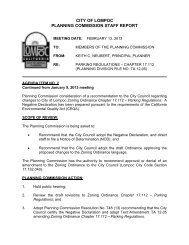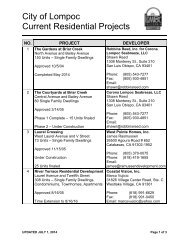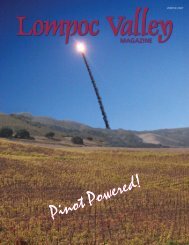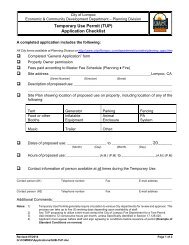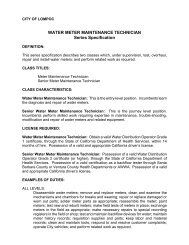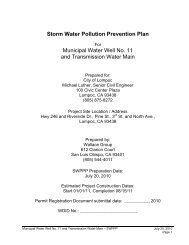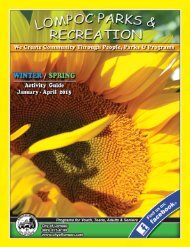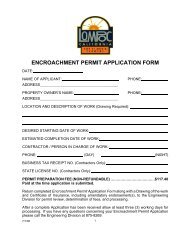Noise and Air Quality - the City of Lompoc!
Noise and Air Quality - the City of Lompoc!
Noise and Air Quality - the City of Lompoc!
- No tags were found...
You also want an ePaper? Increase the reach of your titles
YUMPU automatically turns print PDFs into web optimized ePapers that Google loves.
<strong>City</strong> <strong>of</strong> <strong>Lompoc</strong> General Plan UpdateIssue Paper on <strong>Noise</strong> <strong>and</strong> <strong>Air</strong> <strong>Quality</strong> Issues<strong>and</strong> <strong>the</strong>n carried back onshore <strong>the</strong> following day. Dispersion <strong>of</strong> pollutants is fur<strong>the</strong>r degradedwhen <strong>the</strong> wind velocity for both day <strong>and</strong> nighttime breezes is low.The region is also subject to seasonal “Santa Ana” winds. These are typically hot, dry nor<strong>the</strong>rlywinds which blow <strong>of</strong>fshore at 15-20 mph, but can reach speeds <strong>of</strong> over 60 mph. Two types <strong>of</strong>temperature inversions (warmer air on top <strong>of</strong> cooler air) are created in <strong>the</strong> area: subsidence <strong>and</strong>radiational. The subsidence inversion is a regional effect created by <strong>the</strong> Pacific high in which airis heated as it is compressed when it flows from <strong>the</strong> high pressure area to <strong>the</strong> low pressureareas inl<strong>and</strong>. This type <strong>of</strong> inversion generally forms at about 1,000 to 2,000 feet <strong>and</strong> can occurthroughout <strong>the</strong> year, but it is most evident during <strong>the</strong> summer months. Surface inversions areformed by <strong>the</strong> more rapid cooling <strong>of</strong> air near <strong>the</strong> ground during <strong>the</strong> night, especially duringwinter. This type <strong>of</strong> inversion is typically lower (0-500 feet at V<strong>and</strong>enberg AFB, for example)<strong>and</strong> is generally accompanied by stable air. Both types <strong>of</strong> inversions limit <strong>the</strong> dispersal <strong>of</strong> airpollutants within <strong>the</strong> regional airshed, with <strong>the</strong> more stable <strong>the</strong> air (low wind speeds, uniformtemperatures), <strong>the</strong> lower <strong>the</strong> amount <strong>of</strong> pollutant dispersion.The APCD is required to monitor air pollutant levels to assure that applicable air qualityst<strong>and</strong>ards are met, <strong>and</strong> if <strong>the</strong>y are not met, to develop strategies to meet <strong>the</strong> st<strong>and</strong>ards.Depending on whe<strong>the</strong>r <strong>the</strong> st<strong>and</strong>ards are met or exceeded, <strong>the</strong> air basin is classified as being in“attainment” or as “non-attainment”.Local Issues. Santa Barbara County is considered in attainment <strong>of</strong> <strong>the</strong> federal eight-hour ozonest<strong>and</strong>ard, but does not meet <strong>the</strong> state one-hour ozone st<strong>and</strong>ard or <strong>the</strong> st<strong>and</strong>ard for particulatematter less than ten microns in diameter (PM 10 ). The County is in attainment for all o<strong>the</strong>rst<strong>and</strong>ards. Table 2 summarizes <strong>the</strong> annual air quality data for <strong>the</strong> local airshed.Table 2Ambient <strong>Air</strong> <strong>Quality</strong> Data at <strong>the</strong> S H Street Monitoring StationPollutant 2004 2005 2006Ozone, ppm – Worst Hour 0.084 0.064 0.056Number <strong>of</strong> days <strong>of</strong> State exceedances (>0.09 ppm) 0 0 0Number <strong>of</strong> days <strong>of</strong> Federal exceedances (>0.12 ppm) 0 0 0Particulate Matter 50 μg/m 3 ) 1 1 0Number <strong>of</strong> samples <strong>of</strong> Federal exceedances (>150 μg/m 3 ) 0 0 0Nitrogen Dioxide (ppm), Worst Hour 0.036 0.035 0.037Number <strong>of</strong> days <strong>of</strong> State exceedances (>0.25 ppm) 0 0 0Source: CARB 2004-2006Man-made sources <strong>of</strong> PM 10 include agricultural operations, industrial processes, combustion <strong>of</strong>fossil fuels, construction <strong>and</strong> demolition operations, <strong>and</strong> entrainment <strong>of</strong> road dust into <strong>the</strong>atmosphere. Natural sources include wind blown dust, wildfire smoke, <strong>and</strong> sea spray salt. Dueto <strong>the</strong> County’s non-attainment status for state PM 10 st<strong>and</strong>ards, future development within <strong>the</strong><strong>City</strong> is required to implement <strong>the</strong> Santa Barbara County <strong>Air</strong> Pollution Control District (APCD)best management practices intended to reduce PM 10 emissions.3<strong>City</strong> <strong>of</strong> <strong>Lompoc</strong>



